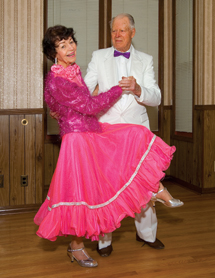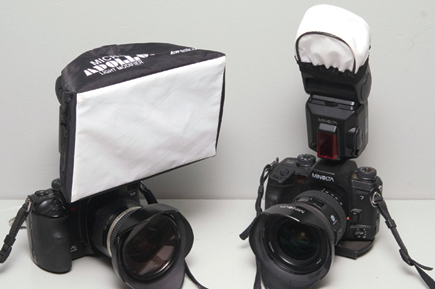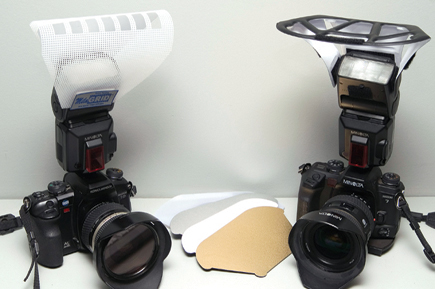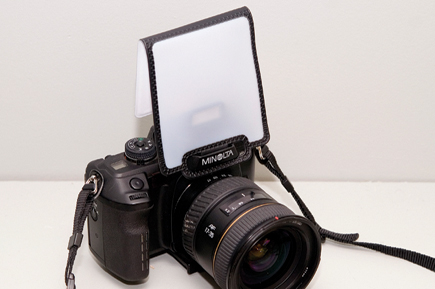On-Camera Flash; Softbox In A Pocket
Recently, I had an assignment to photograph food for publication. It was to be photographed at the home of the writer. Not knowing what to expect I arrived with a carload of strobes, Photoflex light modifiers, Avenger light stands, and various sizes of white and black foamcore to reflect and block light. The food was laid out on a table under a large chandelier. I took one look, dragged the table forward so that the light came from behind the food, kicked in fill light using white foamcore held in place with an Avenger C-stand, and blocked unwanted light reflecting off the silver serving platter with a piece of black foamcore, using a second C-stand and extension arm. I took my time, of course, so the client would think there was a lot involved, but in the end the image of Beef Wellington on a silver serving platter with a red rose garnish ended up on the cover of a food magazine. If it only was always that easy.
 |
|
|
But what if it could always be that easy? What if we were able to carry a
softbox in our pocket? With the latest generation of on-camera flash diffusers
and integral flash diffusers we're often able to do just that. And while
softbox-style frontal lighting isn't good for everything, it comes in
handy a lot of the time.
I have been using a LumiQuest Ultrasoft since it was first introduced about
20 years ago. I happened to be at Samy's Camera in Los Angeles, saw it
hanging on a display and bought it on the spot. I still use that same diffuser
today, and find it especially useful for fill flash in bright daylight. I have
lost count of how many wedding candids I've photographed using the Ultrasoft
mounted on a Vivitar 285HV on-camera flash.
More recently, I have found myself on a lot of location assignments for the
local newspaper. Once a month they call and ask me to photograph the cover story
for their monthly glossy business insert. On the first few assignments I took
all of my lights and stands with me. Then I discovered that on all but the most
complex assignments I can use an on-camera flash with a diffuser.
What a diffuser, or light modifier, does is turn an otherwise harsh, on-camera
flash into a soft, diffused light which can be used for either key or fill.
The difference between on-camera flash modifiers and full-size studio softboxes,
such as the Photoflex LiteDome which fits on stand-mounted strobes, is a matter
of size. And while it is true that the larger the softbox, the softer the light,
it turns out that the smaller handheld units can have a more even distribution,
as the big boxes sometimes exhibit hot spots.
My assignments for the newspaper have ranged from portraits to large group photos
in which even distribution of light is as important as the soft quality. For
this reason, I decided to test a variety of on-camera flash light modifiers
to see if I could improve the quality of my images using this technique.
Variety Of Models
It turns out there are many different models available since LumiQuest first
introduced the Ultrasoft and Pocket Bouncer. I was able to identify eight different
companies producing modifiers. Among the ones I found were a few that were flash
specific. I own three different on-camera flash units, the Minolta 5600HS, Vivitar
285HV, and Sunpak 555, all popular in their day. The flash-specific units are
generally made to fit the more common Canon and Nikon flashes, so I was not
able to test them. This was unfortunate as some such as the Gary Fong C3 Cloud
Lightsphere II is highly rated by photographers who have used it.
What I was able to test were the Westcott Micro Apollo, MilaGrid PowerGrid,
LumiQuest ProMax 80-20 System, and Dot Line Universal Flash Diffuser (#1 and
#2).
 |
|
|
 |
|
|
I was also able to test an integral flash diffuser. By integral flash I mean the pop-up flash on the top of many cameras. These handy little pop-up flashes invariably create a harsh lighting effect, even if you use them as fill. What would happen if we were able to diffuse them? Would we have a ready and always available source of quality light? The one I tested was the LumiQuest Soft Screen (#3).
 |
|
|
What all these units have in common is the ability to spread light in order
to soften its effect on the subject. While the designs vary, they all have a
method for attachment to a flash or camera, usually involving touch fasteners,
and sometimes a strap that wraps around the flash head. There appears to be
three distinct approaches taken by the on-flash diffusers.
The first is to aim the flash directly at the subject through diffusion material.
This type of diffuser works well when photographing large groups of people,
where a wider spread of light and more intensity is required.
The Westcott Micro Apollo uses a cloth diffuser similar to the material used
on full-size softboxes. The result of this design is a shadow cast directly
behind the subject. To lessen this effect I suggest moving the on-camera flash
away from the camera via a flash bracket, such as a Manfrotto 3429. Depending
on the height of the bracket the shadow will drop either just above or below
the subject's shoulder line--a wedding photographer's trick.
The second design is to split the light, some of it going directly to the subject
and the rest bounced off the ceiling. This results in less light falling directly
on the subject, but softer shadows behind the head and an overall more pleasing
light, especially for one subject or small groups of people. The MilaGrid PowerGrid
and the LumiQuest 80-20 both use this method.
The third approach, taken by the Dot Line Universal Flash Diffuser and STO-FEN
Omni-Bounce, is to bounce the light off a panel placed over the flash at a 60Þ
angle, through diffusing material and onto the subject. The LumiQuest ProMax
80-20 System comes packaged with white, silver, and gold inserts and a milky
translucent diffusion panel to convert the 80-20 from ceiling bounce to this
more direct method.
Integral diffusers consist of diffusion material placed in front of the pop-up
flash to spread the light. The LumiQuest Soft Screen attaches via a tab that
slips into the hot shoe above the pop-up. In case there is no hot shoe LumiQuest
provides a touch fastener tab that can be attached to the space where one might
have been.
So, four systems of on-flash diffuser with four unique designs, and one integral
diffuser makes five to test. But wait, there is also the 80-20's second
method of direct bounce, so that makes six.
To test the units I used a mannequin head. I placed the head on top of a tripod
with a coat thrown over the plastic base. I placed the head 5 ft from the wall,
a fairly common distance when working with subjects in a confined space. The
ceiling was white and 9 ft high. I used a Minolta AF 75-300mm f/4.5 lens set
at 100mm on a Minolta 7D camera. This focal length is equivalent to about 150mm
on a full-frame 35mm camera. For the on-camera flash tests I used the Minolta
5600HS. For the STO-FEN Omni-Bounce I used a Sunpak 555, and for the integral
flash diffusers, the pop-up flash on the camera. The on-camera flash images
were made using a Manfrotto flash bracket so that the light source was approximately
12" above the center of the lens (see my comment earlier about using flash
brackets).
- Log in or register to post comments

































